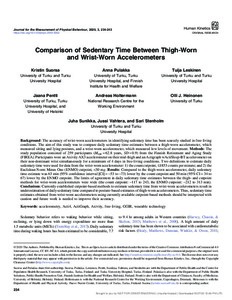Comparison of Sedentary Time Between Thigh-Worn and Wrist-Worn Accelerometers
Kristin Suorsa; Anna Pulakka; Tuija Leskinen; Jaana Pentti; Andreas Holtermann; Olli J. Heinonen; Juha Sunikka; Jussi Vahtera; Sari Stenholm
https://urn.fi/URN:NBN:fi-fe2021042826234
Tiivistelmä
Background: The accuracy of wrist-worn accelerometers in identifying sedentary time has been scarcely studied in free-living conditions. The aim of this study was to compare daily sedentary time estimates between a thigh-worn accelerometer, which measured sitting and lying postures, and a wrist-worn accelerometer, which measured low levels of movement. Methods: The study population consisted of 259 participants (Mage = 62.8 years, SD = 0.9) from the Finnish Retirement and Aging Study (FIREA). Participants wore an Axivity AX3 accelerometeron their mid-thigh and an Actigraph wActiSleep-BT accelerometer on their non-dominant wrist simultaneously for a minimum of 4 days in free-living conditions. Two definitions to estimate daily sedentary time were used for data from the wrist-worn accelerometer: 1) the count cutpoint, ≤1853 counts per minute; and 2) the Euclidean Norm Minus One (ENMO) cutpoint, <30 mg. Results: Compared to the thigh-wornaccelerometer, daily sedentary time estimate was 63 min (95% confidence interval [CI] = −53 to −73) lower by the count cutpoint and 50 min (95% CI = 34 to 67) lower by the ENMO cutpoint. The limits of agreement in daily sedentary time estimates between the thigh- and cutpoint methods for wrist-worn accelerometers were wide (the count cutpoint: −117 to 243, the ENMO cutpoint: −212 to 313 min). Conclusions: Currently established cutpoint-based methods to estimate sedentary time from wrist-worn accelerometers result in underestimation of daily sedentary time compared to posture-based estimates of thigh-worn accelerometers. Thus, sedentary time estimates obtained from wrist-worn accelerometers using currently available cutpoint-based methods should be interpreted with caution and future work is needed to improve their accuracy.
Kokoelmat
- Rinnakkaistallenteet [27094]
